GCSE Biology AQA (Organisation)
4.0(1)
Card Sorting
1/54
Study Analytics
Name | Mastery | Learn | Test | Matching | Spaced |
|---|
No study sessions yet.
55 Terms
1
New cards
Specialised cells
As an organism develops, cells differentiate to form different types of cells.
As a cell differentiates:
- it may change shape
- different sub-cellular structures develop to let it to carry out a specific function.
Include cells such as sperm, nerve and muscle cells.
As a cell differentiates:
- it may change shape
- different sub-cellular structures develop to let it to carry out a specific function.
Include cells such as sperm, nerve and muscle cells.
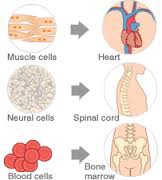
2
New cards
Sperm cell
Tail: to propel the sperm to fertilise the egg.
Mitochondria: sperm have many of these cell components, which are the major site of respiration, to provide energy for their journey.
Nucleus: contains only one set of the genetic material.
Acrosome: contains enzymes to allow the sperm to penetrate the outer layer of the egg.
Mitochondria: sperm have many of these cell components, which are the major site of respiration, to provide energy for their journey.
Nucleus: contains only one set of the genetic material.
Acrosome: contains enzymes to allow the sperm to penetrate the outer layer of the egg.
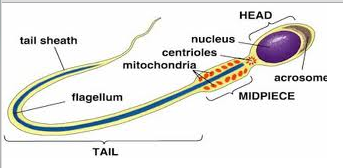
3
New cards
Muscle cell
Contains:
- nucleus
- many mitochondria for energy
- protein fibres that can contract
- nucleus
- many mitochondria for energy
- protein fibres that can contract
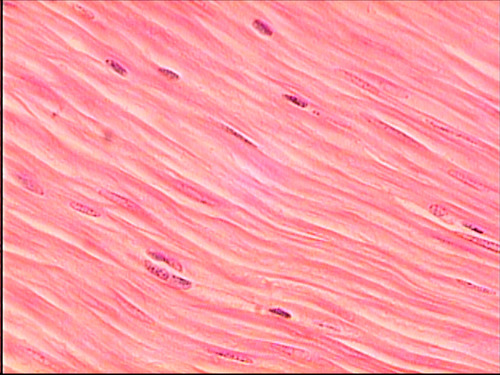
4
New cards
Motor neurone
Contains:
- dendrites
- cell body
- axon
- sheath (acts as an insulator)
- dendrites
- cell body
- axon
- sheath (acts as an insulator)
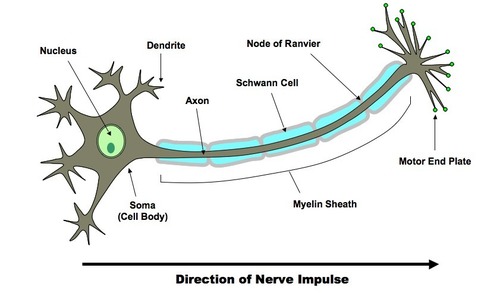
5
New cards
Xylem cell
The cells are arranged end to end but the end walls break down to form hollow tubes.
The cell wall of the cell is strengthened by a substance called lignin.
The cell wall of the cell is strengthened by a substance called lignin.
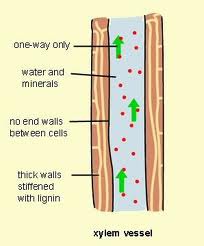
6
New cards
Phloem cell
The end wall of the cells allow sugars through but support the tubes.
The cells are arranged end to end into tubes.
Contain companion cells.
The cells are arranged end to end into tubes.
Contain companion cells.
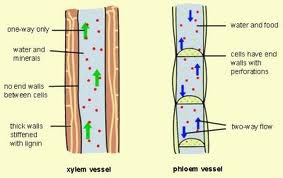
7
New cards
Root hair cell
Lots of mitochondria for active transport of minerals.
Long projection to increase the surface area to absorb water and minerals.
Long projection to increase the surface area to absorb water and minerals.

8
New cards
Tissue
A group of cells with a similar structure and function, which all work together to do a job.
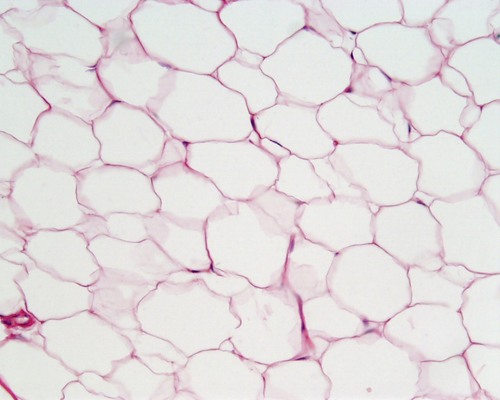
9
New cards
Examples of tissues
- muscle tissue contracts to produce movement
- glandular tissue produces substances such as enzymes and hormones
- epithelial tissue covers organs
- glandular tissue produces substances such as enzymes and hormones
- epithelial tissue covers organs
10
New cards
Organs
Groups of different tissues, which all work together to perform a specific job.
Each may contain several tissues.
Each may contain several tissues.

11
New cards
Stomach
An organ that contains:
- muscle tissue that contracts to churn the contents
- glandular tissue to produce digestive juices
- epithelial tissue to cover the outside and inside of the stomach
- muscle tissue that contracts to churn the contents
- glandular tissue to produce digestive juices
- epithelial tissue to cover the outside and inside of the stomach
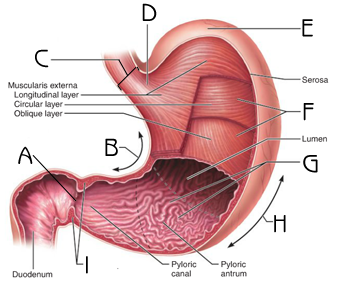
12
New cards
Organ systems
Groups of organs working together to do a particular job.
The digestive system is an example of it, in which several organs work together to digest and absorb food.
Lots of them work together to make an organism.
The digestive system is an example of it, in which several organs work together to digest and absorb food.
Lots of them work together to make an organism.
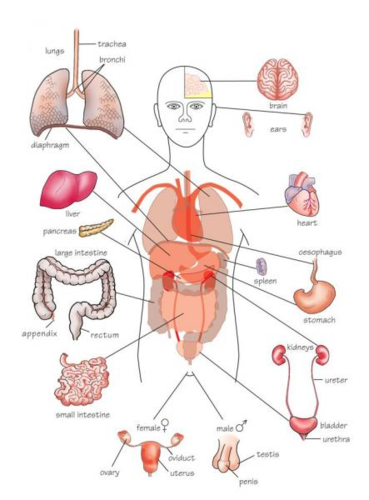
13
New cards
The digestive system
Includes:
- mouth
- oesophagus - pushes food down to stomach
- liver
- stomach
- pancreas
- gall bladder
- large intestine
- small intestine
- rectum
- anus
- mouth
- oesophagus - pushes food down to stomach
- liver
- stomach
- pancreas
- gall bladder
- large intestine
- small intestine
- rectum
- anus
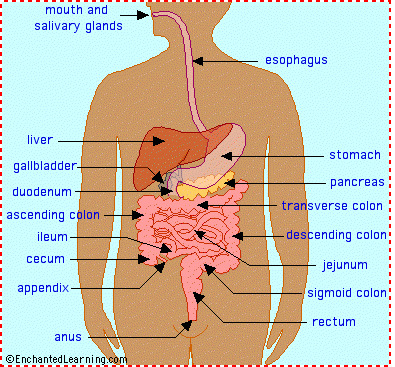
14
New cards
Enzymes
They are biological catalysts - they speed up chemical reactions in living organisms.
They have a number of properties:
- they are all large proteins.
- each of it catalyses a specific reaction.
They have a number of properties:
- they are all large proteins.
- each of it catalyses a specific reaction.
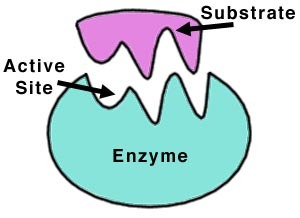
15
New cards
Active site
A space within the protein molecule of the enzyme.
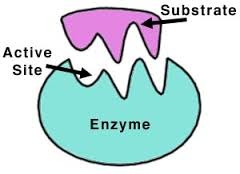
16
New cards
Optimum
Where enzymes work best at a specific temperature and pH.
17
New cards
Lock and key theory
A model used to explain how enzymes work: the chemical that reacts is called the substrate (key) and it fits into the enzyme's active site (lock).
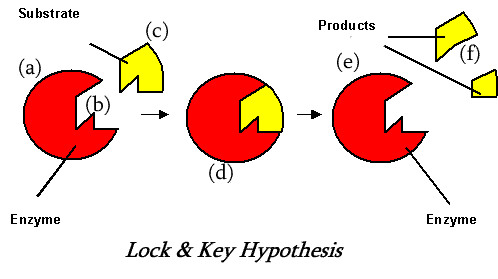
18
New cards
Denaturing
Where high temperature and extremes of pH make enzymes change shape.
The enzyme cannot work once it has been denatured, because the substrate cannot fit into the active site - the lock and key no longer fit together.
The enzyme cannot work once it has been denatured, because the substrate cannot fit into the active site - the lock and key no longer fit together.
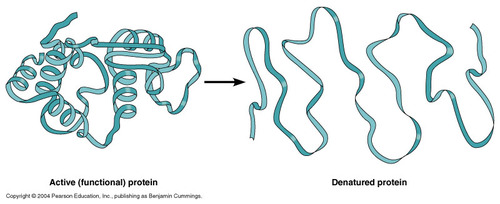
19
New cards
Digestive enzymes
Produced by specialised cells in glands and in the lining of the gut:
- the enzymes pass out of the cells into the digestive system.
- they come into contact with food molecules.
- they catalyse the breakdown of large insoluble food molecules into smaller soluble molecules.
- the enzymes pass out of the cells into the digestive system.
- they come into contact with food molecules.
- they catalyse the breakdown of large insoluble food molecules into smaller soluble molecules.
20
New cards
Examples of digestive enzymes
Protease: digest proteins
Lipase: digest lipids (fats and oils)
Carbohydrase: digest carbohydrates
These are to produce smaller molecules that can be easily absorbed into the bloodstream.
Lipase: digest lipids (fats and oils)
Carbohydrase: digest carbohydrates
These are to produce smaller molecules that can be easily absorbed into the bloodstream.
21
New cards
Amylase
- is produced in the salivary glands and the pancreas
- is a carbohydrase that breaks down starch into sugar (maltose).
Used to build new carbohydrates.
- is a carbohydrase that breaks down starch into sugar (maltose).
Used to build new carbohydrates.
22
New cards
Protease
- is produced in the stomach, pancreas and small intestine
- breaks down proteins into peptides or amino acids.
Used to build new proteins.
- breaks down proteins into peptides or amino acids.
Used to build new proteins.
23
New cards
Lipase
- is produced in the pancreas and small intestine
- breaks down lipids (fats) into fatty acids and glycerol.
Used to build new lipids.
- breaks down lipids (fats) into fatty acids and glycerol.
Used to build new lipids.
24
New cards
Bile
It is a liquid made in the liver and stored in the gall bladder.
It is alkaline to neutralise hydrochloric acid from the stomach.
It also emulsifies fat to form small droplets, increasing the surface area for enzymes to act on.
The alkaline conditions and large surface area increase the rate at which fat is broken down by lipase.
Does not contain any enzymes, so it does not digest fat molecules. It just breaks up fat droplets into smaller ones.
It is alkaline to neutralise hydrochloric acid from the stomach.
It also emulsifies fat to form small droplets, increasing the surface area for enzymes to act on.
The alkaline conditions and large surface area increase the rate at which fat is broken down by lipase.
Does not contain any enzymes, so it does not digest fat molecules. It just breaks up fat droplets into smaller ones.
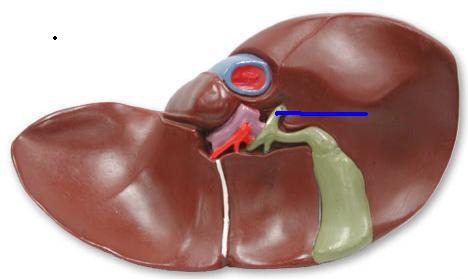
25
New cards
Good health
A state of physical and mental wellbeing.
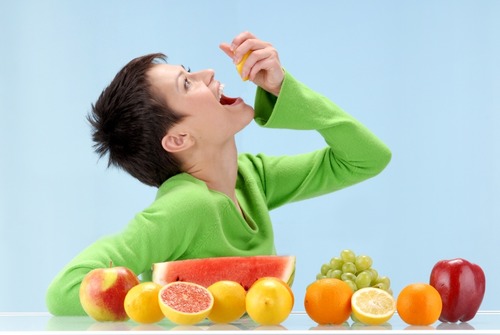
26
New cards
Disease
Caused by part of the body not working properly.
This can affect physical and / or mental health.
Can be divided into two main types:
- communicable
- non-communicable
This can affect physical and / or mental health.
Can be divided into two main types:
- communicable
- non-communicable
27
New cards
Examples of how different diseases can interact with each other
- viruses infecting cells can be the trigger for cancers, such as cervical cancer.
- diseases of the immune system mean that an individual is more likely to catch infectious diseases, e.g. people with HIV are more likely to get tuberculosis.
- immune reactions triggered by a pathogen can cause allergies, such as skin rashes and asthma.
- if a person is physically ill, this can lead to depression and mental illness.
- poor diet, stress, and difficult life situations can increase the likelihood of developing certain diseases.
- diseases of the immune system mean that an individual is more likely to catch infectious diseases, e.g. people with HIV are more likely to get tuberculosis.
- immune reactions triggered by a pathogen can cause allergies, such as skin rashes and asthma.
- if a person is physically ill, this can lead to depression and mental illness.
- poor diet, stress, and difficult life situations can increase the likelihood of developing certain diseases.
28
New cards
Casual mechanism
The process by which a cause brings about an effect.
29
New cards
Risk factor
They make it more likely that a person will develop a certain disease.
Non-communicable diseases are often caused by the interaction of a number of factors.
They can be:
- aspects of a person's lifestyle
- substances in the person's body or environment
Non-communicable diseases are often caused by the interaction of a number of factors.
They can be:
- aspects of a person's lifestyle
- substances in the person's body or environment
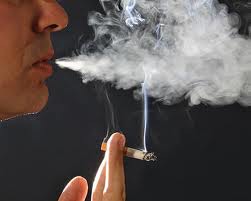
30
New cards
Examples of diseases and their proven risk factors
Cardiovascular disease: lack of exercise / smoking / high intake of saturated fat
Type 2 diabetes: Obesity
Liver and brain damage: Excessive alcohol intake
Lung diseases, including lung cancer: Smoking
Skin cancer: Ionising radiation, e.g. UV light
Low birth weight in babies: Smoking during pregnancy
Brain damage in babies: Excessive alcohol intake during pregnancy
Type 2 diabetes: Obesity
Liver and brain damage: Excessive alcohol intake
Lung diseases, including lung cancer: Smoking
Skin cancer: Ionising radiation, e.g. UV light
Low birth weight in babies: Smoking during pregnancy
Brain damage in babies: Excessive alcohol intake during pregnancy
31
New cards
Coronary heart disease
Layers of fatty material build up inside the coronary arteries and narrow them.
Treatment for it include:
- stents to keep the coronary arteries open
- statins to reduce blood cholesterol levels and slow down the rate at which fatty materials build up
Treatment for it include:
- stents to keep the coronary arteries open
- statins to reduce blood cholesterol levels and slow down the rate at which fatty materials build up
32
New cards
Heart valve disease
In some people, heart valves may become faulty, developing a leak or preventing the valve from opening fully.
Faulty valves can be replaced using biological or mechanical valves.
Faulty valves can be replaced using biological or mechanical valves.
33
New cards
Treatments of heart failure
- a donor heart, or heart and lungs, can be transplanted
- artificial hearts can be used to keep patients alive while waiting for a heart transplant or to allow the heart to recover
- drugs such as clot-busting enzymes or warfarin are sometimes used to treat recovering patients, while statins can be given to lower cholesterol levels
- artificial hearts can be used to keep patients alive while waiting for a heart transplant or to allow the heart to recover
- drugs such as clot-busting enzymes or warfarin are sometimes used to treat recovering patients, while statins can be given to lower cholesterol levels
34
New cards
Cancer
It is a non-communicable disease,
Scientists have identified lifestyle risk factors for some types of cancer, e.g. smoking, obesity, common viruses and UV exposure.
It is caused by uncontrolled cell division. This can form masses of cells called tumours.
There are two main types of tumours:
- benign tumours do not spread around the body
- malignant tumours spread, in the blood, to different parts of the body where they form secondary tumours
Scientists have identified lifestyle risk factors for some types of cancer, e.g. smoking, obesity, common viruses and UV exposure.
It is caused by uncontrolled cell division. This can form masses of cells called tumours.
There are two main types of tumours:
- benign tumours do not spread around the body
- malignant tumours spread, in the blood, to different parts of the body where they form secondary tumours
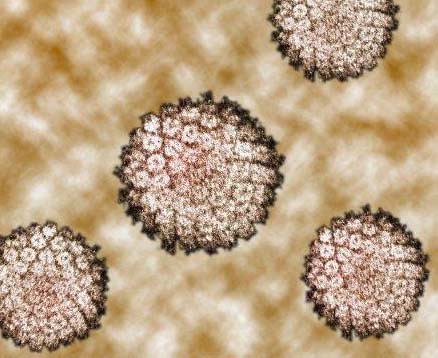
35
New cards
Epidermis
Covers the outer surfaces of the plant for protection.
36
New cards
Palisade mesophyll
The main site of photosynthesis in the leaf.
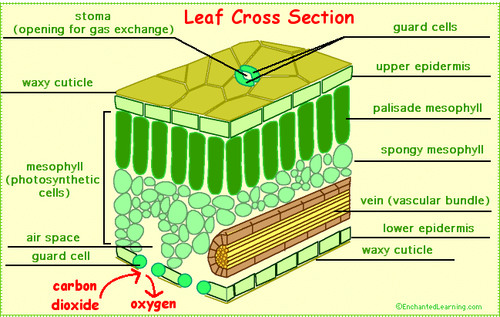
37
New cards
Spongy mesophyll
Air spaces between the cells allow gases to diffuse through the leaf.
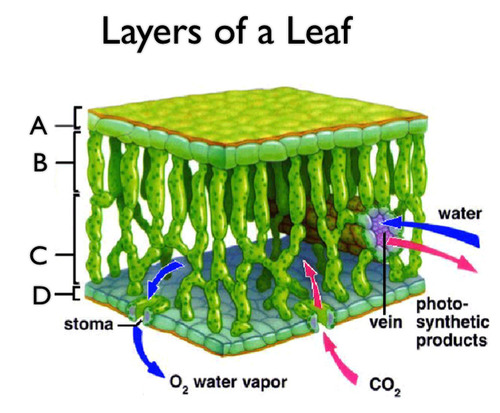
38
New cards
Xylem vessels
Transports water and minerals through the plant, from roots to leaves. Also supports the plant.
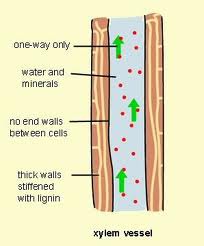
39
New cards
Phloem vessels
Transports dissolved food materials through the plant.
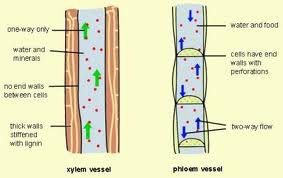
40
New cards
Meristem tissue
Found mainly at the tips of the roots and shoots, where it can produce new cells for growth.
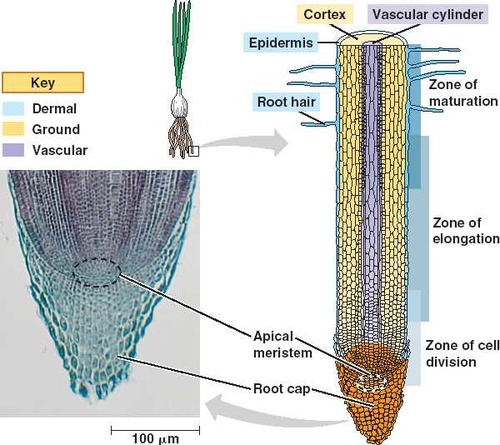
41
New cards
Wax cuticle
To protect the leaf without blocking out light.
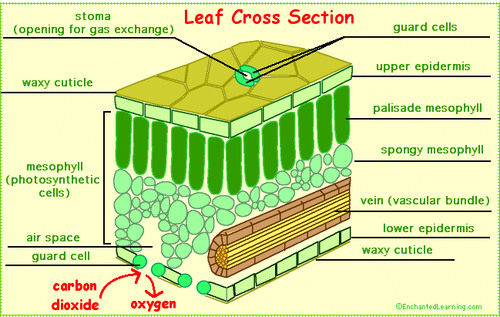
42
New cards
Stomata
Allow the diffusion of gases in and out of the leaf and can be opened and closed by guard cells.
The role of the guard cell is to open and close stomata.
At night, the stomata is closed. This is because carbon dioxide is not needed for photosynthesis, so closing stomata reduces water loss.
When water is plentiful, guard cells take up water and bend. This causes the stomata to open, so gases for photosynthesis are free to move in and out of the stomata along with water from transpiration.
When water is scarce, losing water makes the stomata change shape and close. This stops the plant from losing more water through transpiration.
The role of the guard cell is to open and close stomata.
At night, the stomata is closed. This is because carbon dioxide is not needed for photosynthesis, so closing stomata reduces water loss.
When water is plentiful, guard cells take up water and bend. This causes the stomata to open, so gases for photosynthesis are free to move in and out of the stomata along with water from transpiration.
When water is scarce, losing water makes the stomata change shape and close. This stops the plant from losing more water through transpiration.
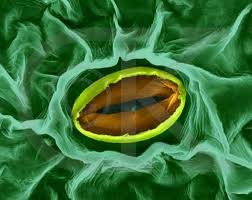
43
New cards
Transpiration
The loss of water from the leaves.
It helps to draw water up the xylem vessels from the roots.
It helps to draw water up the xylem vessels from the roots.
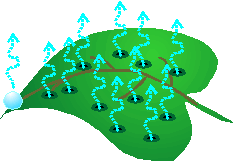
44
New cards
Factors that affect the rate of transpiration
- an increase in temperature will increase the rate, as more energy is transferred to the water to allow it to evaporate
- faster air flow will increase the rate, as it will blow away water vapour allowing more to evaporate
- increased light intensity will increase the rate, as it will cause stomata to open
- an increase in humidity will decrease the rate as the air contains more water vapour, so the concentration gradient for diffusion is lower
- faster air flow will increase the rate, as it will blow away water vapour allowing more to evaporate
- increased light intensity will increase the rate, as it will cause stomata to open
- an increase in humidity will decrease the rate as the air contains more water vapour, so the concentration gradient for diffusion is lower
45
New cards
Translocation
The movement of food through phloem tissue.
46
New cards
Blood
It is a tissue made of a liquid called plasma, which has three different components suspended to it:
- red _____ cells
- white _____ cells
- platelets
Transports various chemical substances around the body, such as the products of digestion, hormones, antibodies, urea and carbon dioxide.
- red _____ cells
- white _____ cells
- platelets
Transports various chemical substances around the body, such as the products of digestion, hormones, antibodies, urea and carbon dioxide.
47
New cards
Red blood cells
- contains haemoglobin, which binds to oxygen to transport it to lungs to the tissues and cells, which need it for respiration
- do not contain a nucleus, so there is more room for haemoglobin
- are very small, so they can fit through the tiny capillaries
- are shaped like biconcave discs, giving them a large surface area that oxygen can quickly diffuse across.
- do not contain a nucleus, so there is more room for haemoglobin
- are very small, so they can fit through the tiny capillaries
- are shaped like biconcave discs, giving them a large surface area that oxygen can quickly diffuse across.
48
New cards
White blood cells
- help to protect the body against infection
- can change shape, so they can squeeze out the blood vessels into the tissues or surround and engulf microorganisms.
- can change shape, so they can squeeze out the blood vessels into the tissues or surround and engulf microorganisms.
49
New cards
Platelets
Fragments of cells, which collect at wounds and trigger blood clotting.
50
New cards
Arteries
- take blood from your heart to your organs
- thick walls made from muscle and elastic fibres
- thick walls made from muscle and elastic fibres
51
New cards
Veins
- take blood from your organs to your heart
- thinner walls and valves to prevent backflow
- thinner walls and valves to prevent backflow
52
New cards
Capillaries
- allow substances needed by the cells to pass out of the blood
- allow substances produced by the cells to pass into the blood
- narrow, thin-walled blood vessels
- allow substances produced by the cells to pass into the blood
- narrow, thin-walled blood vessels
53
New cards
The heart
Pumps blood around the body in a double circulatory system.
Blood passes through it twice on each circuit.
There are four chambers in it:
- the left (pulmonary vein) and right atria (vena cava), which receive blood from veins
- the left (aorta) and right ventricles (pulmonary artery), which pump the blood out into arteries
Blood passes through it twice on each circuit.
There are four chambers in it:
- the left (pulmonary vein) and right atria (vena cava), which receive blood from veins
- the left (aorta) and right ventricles (pulmonary artery), which pump the blood out into arteries
54
New cards
Stages of the heart
Blood enters the heart through the atria.
The atria contract and force blood into the ventricles.
The ventricles then contract and force blood out of the heart.
Valves make sure the blood flows in the correct direction.
The natural resting heart rate is controlled by a group of cells located in the right atrium, which act as a pacemaker.
Artificial pacemakers are electrical devices used to correct irregularities in the heart rate.
The atria contract and force blood into the ventricles.
The ventricles then contract and force blood out of the heart.
Valves make sure the blood flows in the correct direction.
The natural resting heart rate is controlled by a group of cells located in the right atrium, which act as a pacemaker.
Artificial pacemakers are electrical devices used to correct irregularities in the heart rate.
55
New cards
Gaseous exchange
The heart sends blood to the lungs via the pulmonary artery.
Air obtained by breathing reaches the lungs through the trachea (windpipe).
The trachea divides into two tubes - the bronchi.
The bronchi divide to form bronchioles.
The bronchioles divide until they end in tiny air sacs called alveoli.
There are millions of alveoli and they are adapted to be very efficient at exchanging oxygen and carbon dioxide:
- they have a large, moist surface area
- they have a very rich blood supply
- they are very close to the blood capillaries, so the distance for gases to diffuse is small.
The blood is taken back to the lungs through the pulmonary vein.
Air obtained by breathing reaches the lungs through the trachea (windpipe).
The trachea divides into two tubes - the bronchi.
The bronchi divide to form bronchioles.
The bronchioles divide until they end in tiny air sacs called alveoli.
There are millions of alveoli and they are adapted to be very efficient at exchanging oxygen and carbon dioxide:
- they have a large, moist surface area
- they have a very rich blood supply
- they are very close to the blood capillaries, so the distance for gases to diffuse is small.
The blood is taken back to the lungs through the pulmonary vein.